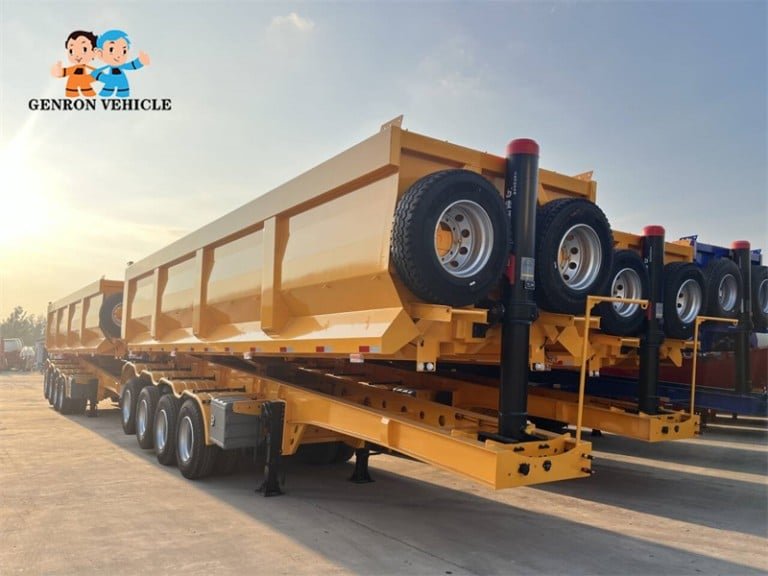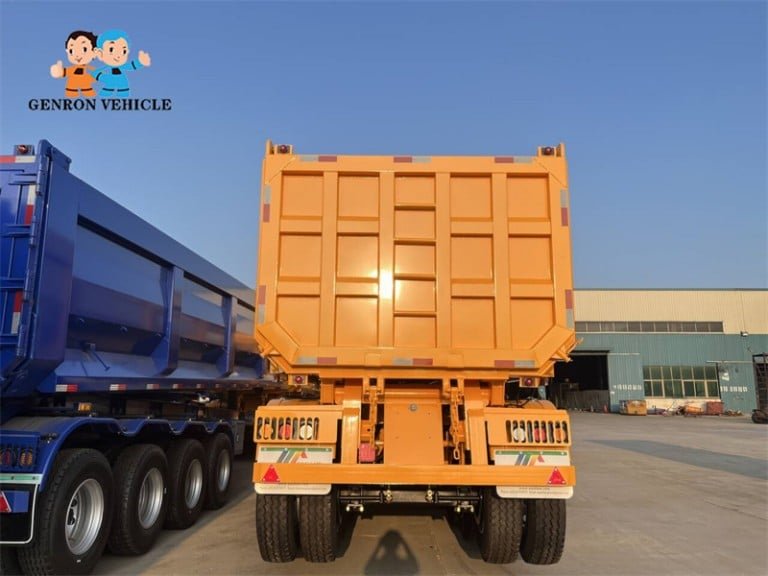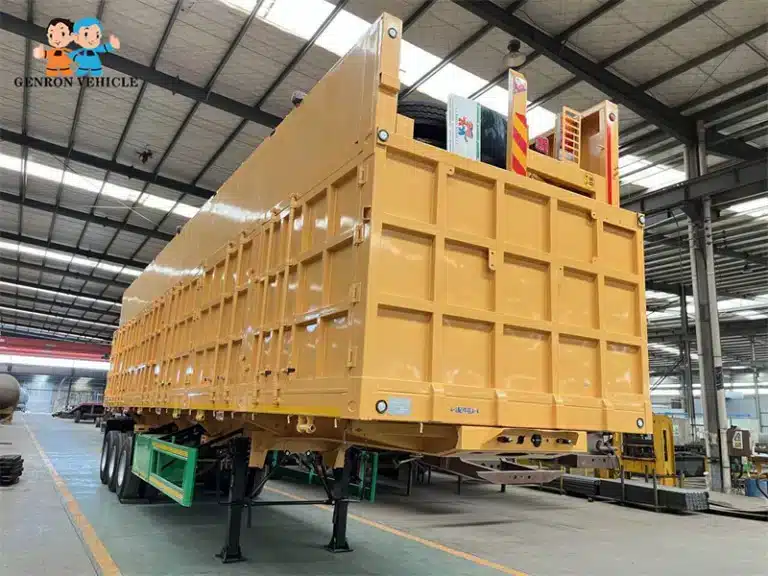End dump trailers are essential for transporting and unloading bulk materials in industries like construction, mining, agriculture, and waste management. These trailers lift their bed at the front to allow materials to slide out the rear, offering efficiency and versatility.
This guide explores the primary types of dump end trailer based on industry standards and manufacturer specifications. Additionally, we will examine their features, capacities, applications, and respective advantages and disadvantages. We’ll also cover key considerations for selection to help you make an informed choice.
Table of Contents
Key Terminology
Before diving in, here are some common terms:
- Hydraulic System: A fluid-powered mechanism that lifts the trailer bed for unloading. They typically achieve dump angles of 45-50 degrees for safety and efficiency.
- Cubic Yard Capacity: Measures the volume of material the trailer can hold (e.g., water-level fill). Actual payload depends on material density and legal weight limits.
- Frameless vs. Framed: Frameless designs are lighter and use the bed as the structure. Framed has a separate chassis for added durability.
- AR450/Hardox Steel: Abrasion-resistant materials used in beds to withstand heavy, abrasive loads like rocks or slag.
Standard End Dump Trailers
Standard end dump trailers are the most common type. They are widely used in industries such as construction, mining, and agriculture. These trailers feature a simple and efficient design, with the front of the body lifted by hydraulic cylinders, allowing material to slide out from the rear. This standard end dump trailer is particularly well-suited for transporting bulk materials such as sand, gravel, and demolition debris.
- Key Features: High sidewalls (typically 48-60 inches), reinforced frames, and options for steel or aluminum construction. Capacities range from 20 to 40 cubic yards.
- Applications: Transporting sand, gravel, demolition debris, or aggregates in construction and road maintenance.
- Pros: Simple design, easy operation, and cost-effective for everyday use.
- Cons: Higher tipping risk on uneven surfaces. It requires careful site preparation to avoid instability.
- Example: Models from MAC Trailer or East Manufacturing offer lightweight aluminum options for better fuel efficiency.
Begin with a bespoke semi-trailer designed for your exact needs. Whether it’s heavy-duty hauling or specialized cargo, we’ve got the perfect solution to keep you moving forward.
Half-Round End Dump Trailers
The unique design of half-round end dump trailers enables exceptional performance in specific applications. Their curved, bowl-shaped body, distinct from traditional flat-bottom designs, is particularly suited for precise control during material unloading. This allows materials to be accurately placed in designated locations. The curved profile also reduces the likelihood of materials adhering to the body.
- Key Features: Bowl-shaped profile, often made from AR450 steel for durability. Their capacities typically 20-30 cubic yards.
- Applications: Precise spreading of gravel on roads, agricultural distribution, or handling sticky materials like asphalt.
- Pros: Better stability during unloading, lower tipping risk. And efficient discharge even with wet or cohesive loads.
- Cons: Slightly lower capacity for bulky materials compared to rectangular designs.
- Example: Ranco or MTM models are popular for paving and aggregate work.
Super End Dump Trailers
High-side end dump trailers, sometimes referred to as “super” in configurations like train setups (lead trailer + pup). Their feature taller sides and extended hydraulic lifts for handling denser or larger volumes.
Note: True 90-degree vertical dumping is rare due to safety concerns. Most achieve 43-50 degrees.
- Key Features: Extra height (up to 72 inches), reinforced cylinders for steeper angles, and capacities of 30-50 cubic yards or more in train setups.
- Applications: Wet concrete, dense clay, heavy aggregates in large-scale construction or mining.
- Pros: Faster unloading cycles, higher payload for volume-focused jobs, and compatibility with elevated hoppers.
- Cons: Increased weight may reduce fuel efficiency; requires powerful tractors.
- Example: East Steel Super Train models for high-volume hauling.
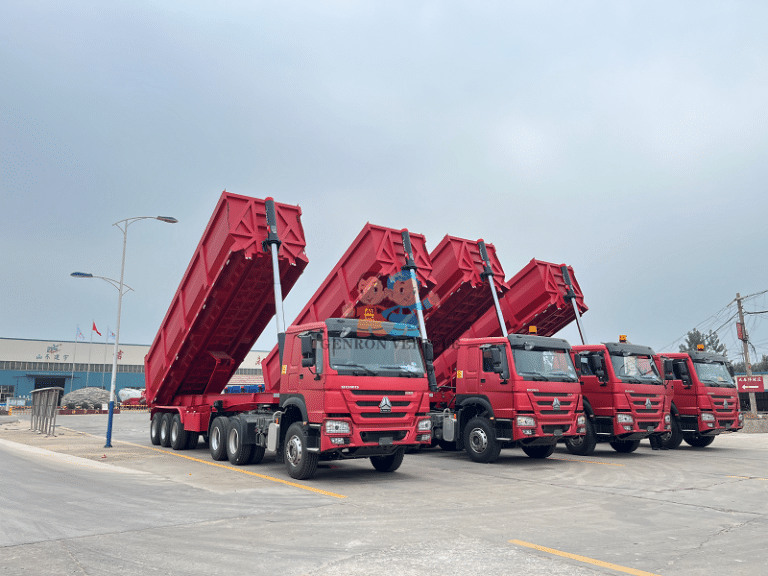
Heavy-Duty End Dump Trailers
Heavy-duty end dump trailers are specifically designed for transporting oversized, high-density materials. Featuring reinforced structures, these trailers handle materials such as rock, concrete, and heavy equipment.
- Key Features: Thicker bed walls (e.g., Hardox steel), multiple axles, high-capacity suspension. Payloads up to 40 tons or more, with capacities exceeding 50 cubic yards.
- Applications: Rocks, concrete, heavy equipment in mining, oil/gas, or industrial sites.
- Pros: Exceptional durability under high pressure. Suitable for over 100-ton gross weights in some configs.
- Cons: Heavier tare weight increases fuel costs, and more maintenance is needed.
- Example: Cancade or Deloupe models with T1 steel chassis.
Off-Road End Dump Trailers
Off-road end dump trailers are specifically designed for non-road environment operations, with particular emphasis on strength and durability.
- Key Features: Oversized tires, increased ground clearance, all-terrain suspension, and reinforced frames; capacities 20-40 cubic yards.
- Applications: Mining, logging, oil/gas fields, or civil engineering in uneven or remote areas.
- Pros: Handles slopes and unstable ground, and optional stabilizing outriggers for safety.
- Cons: Slower on highways and higher initial cost.
- Example: K-Line or Load King models with 43-degree dump angles.
Specialized End Dump Trailers
In addition to common types, there are also specialized end dump trailers designed for specific applications. These trailers include:
- Low-Profile End Dump Trailers: Suitable for applications with height restrictions, these trailers have a lower deck height, making them ideal for operations in low-clearance environments.
- Transfer End Dump Trailers: Allow materials to be dumped into a secondary conveyor or hopper, making them suitable for use in factories or processing plants.
- Vertical End Dump Trailers: Capable of dumping vertically rather than rearward, these trailers are ideal for use in confined spaces.
- Slag End Dump Trailers: Specifically designed for handling hot slag or asphalt materials, these trailers can withstand high temperatures.
These specialized trailers are typically customized to meet the needs of specific industries and are capable of handling unique materials or work environments.
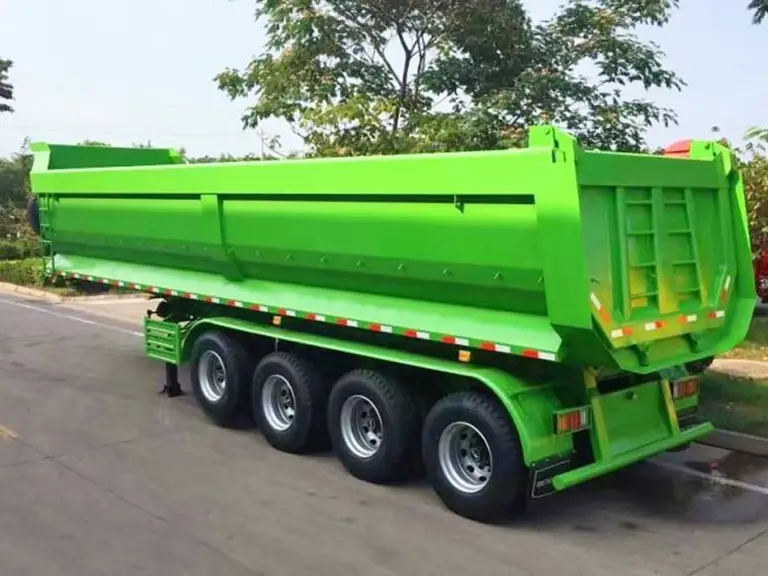
Comparison of End Dump Trailer Types
Here’s a quick reference table for key differences:
| Type | Typical Capacity (cu yd) | Best Materials | Pros | Cons |
|---|---|---|---|---|
| Standard | 20-40 | Sand, gravel | Versatile, affordable | Tipping risk on uneven ground |
| Half-Round | 20-30 | Asphalt, sticky loads | Reduced sticking, stable | Lower bulky load capacity |
| High-Side | 30-50 | Dense aggregates | High volume, fast unload | Heavier, fuel-inefficient |
| Heavy-Duty | 50+ | Rocks, concrete | Extreme durability | High maintenance |
| Off-Road | 20-40 | Remote site hauls | Terrain adaptability | Slower on roads |
Data sourced from manufacturers like MTM and MAC.
Comparison Between Side Dump and End Dump Trailers
When choosing the right dump trailer, both side dump and end dump trailers have their advantages. Side dump trailers, which unload materials to the side rather than the rear, offer greater stability, especially in uneven terrain or confined spaces, making them safer and more efficient. Side dump trailers are well-suited for handling semi-liquid materials and perform better in complex worksite environments.
However, end dump trailers, with their high capacity and ease of operation, remain the preferred choice for many businesses when quick, large-scale transport is needed. Depending on specific job requirements and site conditions, businesses can decide which type of trailer best suits their needs. Both side dump and end dump trailers have unique application values, and businesses should choose based on actual requirements.
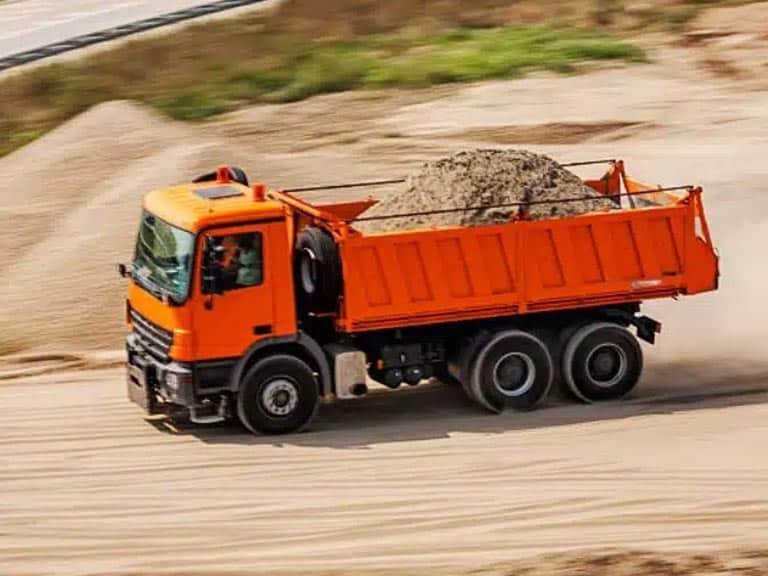
Considerations When Choosing an End Dump Trailer
Choosing the right end dump trailer requires careful consideration of multiple factors to ensure it meets specific business needs:
- Load Capacity: Choose a trailer capacity that matches your business needs to efficiently transport the required materials. Generally, heavier materials require higher load capacities, while lighter materials can use smaller trailers. Check local weight limits via DOT regulations.
- Manufacturing Materials: Steel and aluminum each have their advantages. Steel trailers are durable and suitable for heavy-duty transport. And aluminum trailers are lighter, more corrosion-resistant, and ideal for long-distance transport and fuel savings.
- Hydraulic System: A robust hydraulic system is key to ensuring efficient and safe operations, especially when handling heavy materials. Choosing a reliable hydraulic system can reduce maintenance costs and improve work efficiency.
- Axle Configuration and Suspension System: The number of axles and the type of suspension system will affect the trailer’s stability and load capacity. More axles and high-quality suspension systems can increase the trailer’s load capacity and stability in complex road conditions.
Conclusion
Understanding the different types of end dump trailers and their features helps businesses select the trailer that best suits their needs. Whether it’s a standard, half-round, super, or heavy-duty model, each type of end dump trailer has its specific application scenarios. When choosing, businesses should consider the trailer’s load capacity, manufacturing materials, and hydraulic system based on specific job requirements and environmental conditions to ensure the selected trailer provides the best transportation solution. At Genron International Trade, we are dedicated to providing the highest quality end dump trailers to meet your various transportation needs.
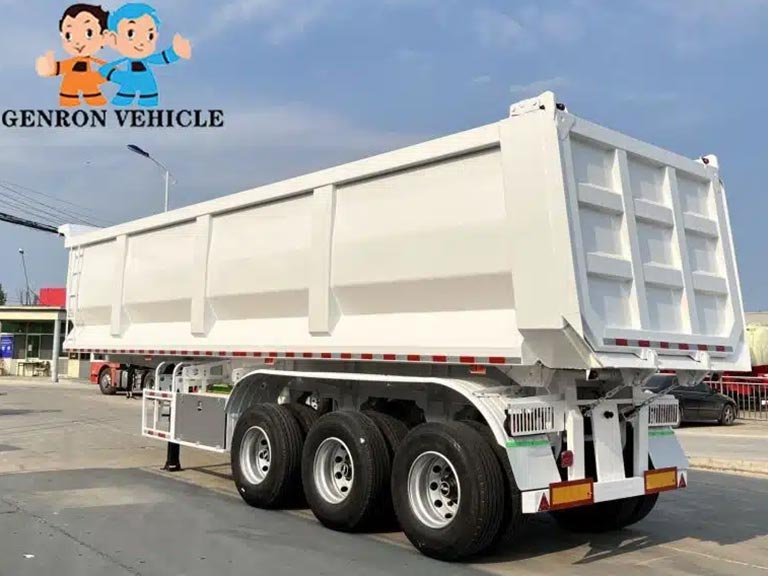
FAQ
What are the different types of dump trailers?
Dump trailers are classified into three types: end dump, side dump, and bottom (belly) dump trailers. And each with its own manner of unloading and suitability for particular materials and job-site circumstances. End dump trailers tilt their beds to unload from the back, side dumps unload from the sides, and belly dumps open from the bottom. Other variants include roll-off trailers, which have detachable bins, and live floor trailers, which employ conveyor belts to unload.
What is an end dump trailer?
An end dump trailer is a type of dump trailer. It unloads cargo by tilting the body upward hydraulically and discharging it from the rear. It’s a multipurpose trailer that’s widely used in construction, garbage management, and material transportation.
What is the difference between side dump and end dump?
Side dump trailers utilize a side-discharge mechanism, offering superior stability on uneven terrain. They feature faster unloading cycles and higher production efficiency. This makes them particularly suitable for site preparation and the transport of fine-grained or liquid materials.
End dump trailers unload from the rear, making them ideal for large, heavy loads of loose material on flat surfaces. Side dumps feature a lower center of gravity, which improves safety and reduces the chance of tipping. However, it carries a lesser payload than end dumps.

